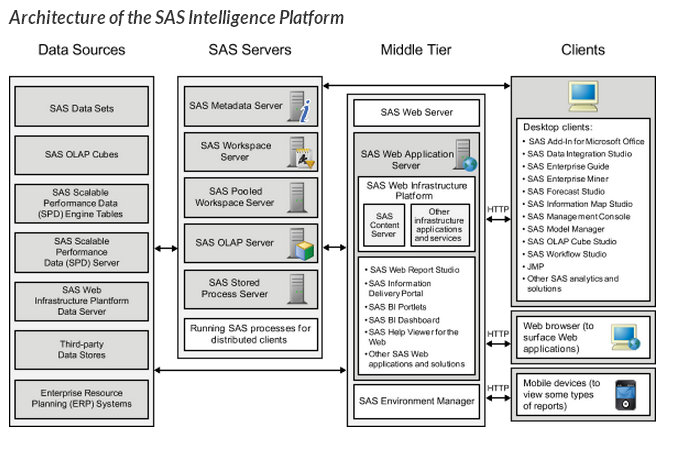You are the new SAS Administrator. After the initial shock or excitement, you sit back and wonder, “What does that MEAN???” In an enterprise environment there are often divisions of duties. The SAS Intelligence Platform is no exception. Just take a look at the architecture.
Just looking at this picture, you can probably tell there are potential turf wars here. As the SAS Administrator you may have to interact with database administrators, server or system administrators, middle tier administrators and even desktop support. In other words, the SAS Administrator will have to know enough to be dangerous about various aspects of the environment. Our SAS Platform Administration: Fast Track course is designed to cover the entire platform in a short amount of time.
But what if you are not the administrator of the entire domain? How do you understand the platform for SAS Business Analytics without drinking from the fire hose that is the SAS Platform Administration: Fast Track? The answer is: It depends. It depends on what type of administrator you are. The good thing about SAS is that it is flexible and configurable, but in the wrong hands, what is good can be bad. So let’s get you started in becoming the best SAS Platform Administrator you can be.
I have to begin by asking you some questions.
- Do you administer the SAS Platform for Business Analytics, but you do not have administrator rights to the server?
- Do you use SAS Management Console and support SAS applications, but you rely on someone else for your operating system administration?
If your answer to these questions is, ‘Yes, that sounds like me!’, then the new SAS Platform Administration: Metadata Administration course if for you! You would be what we call a SAS Metadata Administrator. Your focus is on metadata security, adding users, and business intelligence content, such as SAS Stored Processes or SAS Reports. This course teaches you the terminology and skills to manage the platform for SAS Business Analytics through use of SAS Management Console.
If the last paragraph bored you to tears and you have no desire to manage metadata, BUT you do manage server machines and the processes that run on them, you are not left in the dark. You are the type of administrator we call a SAS System Administrator. To you, your concern for SAS is from the operating system perspective. The course you should take is SAS Platform Administration: System Administration 9.4. With the knowledge gained in this course you will be able to:
- administer and back up the SAS configuration and metadata
- administer, monitor, log and troubleshoot the SAS Metadata Server and other SAS processing servers
- utilize the SAS Environment Manager.
The courses are independent of each other, so you take the course relevant to the type of SAS Administrator you are. If you need both, the fact that they are independent from each other helps because you can take them in any order. Now that you know the type of SAS Administrator you are, we look forward to seeing you in class soon!
If you are completely new to the SAS platform, you may want to take the Getting Started with the platform for SAS Business Analytics course which provides an overview of the platform and the various client applications that it supports. The course is valid regardless of which platform administration course(s) you take.
You can view all of the platform administration courses on the administration curriculum path.


2 Comments
As the role of a SAS Administrator is quite varied and/or specialized, it is great to see these new courses to train and guide SAS Admins. Gregory Nelson at SAS Global Forum 2014 ran a workshop on the role of a SAS Administrator that may be of interest to readers. The workshop material included a detailed mind map on the role and tasks of a SAS Admin... http://blogs.sas.com/content/sgf/2014/06/04/a-day-in-the-life-of-a-sas-administrator-understanding-the-roles-we-play/
The refered picture can be a misleading one. Not seeing the line of desktopclients is passing the midtier at that head. not being connected. These desktopclients are no browser only access, it are thin clients that should be integrated in common existing policies (closed desktop).
From other directions are other mandatory guidelines coming in (SIEM ITIL RBAC etc.). Those guidelines are having implications for metadata design and system configuration. Being in the middle of all that with a lack of recognition on the issues is not a nice position.
And now you are adding a war between types of SAS administrators. Embedding SAS in an professionaI IT approach is already that difficult by political reasons. The major segregation today is a/ design/building new things (changing), b/ having all things run operational, c/ communicate with the business. These tree silos are not well communicating as all having their own goals.
You are so right with: "The good thing about SAS is that it is flexible and configurable, but in the wrong hands, what is good can be bad."